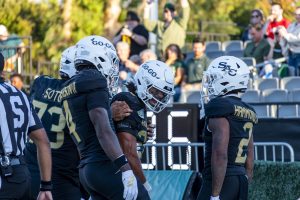Blood drive donors help save lives by the pint
March 2, 2015
Thirty-eight percent of the general U.S. population is eligible to donate blood. Every semester, BloodSource comes to Sacramento State and has hosted numerous blood drives since 1994.
“Sac State and BloodSource have been working together for many decades,” said BloodSource account manager Ashley Smudski. “We’re so appreciative for the partnership. We help out over 40 hospitals in Northern and Central California. We need to collect over 700 products every single day, which includes platelets, red blood cells and plasma.”
The first blood drive of the semester was coordinated by BloodSource and College Assistance Migrant Program (CAMP) on Feb. 24 and 25 in the Unions Ballroom from 10 a.m. to 5 p.m. Participants received $5 credit for Togo’s.
CAMP is an educational program that assists students from migrant and seasonal farm worker backgrounds.
Donors had the option of donating blood in honor of Cesar Chavez, best known for his actions as a civil rights activist.
“We are part of the National Cesar E. Chavez Blood Drive Challenge along with 250 other universities,” said Smudski. “We want to highlight his life because he was a leader and was very involved in community health-oriented goals for himself and for the people he worked with. We’re also promoting him because of his support on community voluntarism.”
Sac State won second place from last year’s Chavez Challenge, donating a total of 441 life-saving pints. This year, Sac State donated a total of 743 pints.
“People like me who have O+ blood have more opportunities to save lives because we are universal blood donors. More people should donate as a unit, instead of individuals,” said senior psychology major Chrystie Martin. “That way, more donations can be attempted and made.”
Participants go through a process before they are able to donate blood. First, they must go through a registration process and then proceed to the donor evaluation area where BloodSource staff members find out if they’re eligible to donate or not. Considered factors include health, travel and medicines. If participants pass the mini physical, they are led to the 40+ blood donation stations in the room.
“It only took them 5 minutes to take my blood and then they asked me to stay seated for another 15 minutes… I’ve been donating blood since high school,” said junior gerontology major April-Lynn Agan. “It’s a great feeling to be able to say I’ve saved a lot of lives.”
Once participants donate blood, they head over to the refreshments table where they are asked to stay, get hydrated, and eat snacks for recuperation.
“So often we have folks that aren’t eligible, but I want to tell everyone how much I need them,” said Smudski when asked what ineligible donors can do to help. “We need over 100 volunteers every single day with traffic control, spreading the word, serving cookies, showing people where to go. If you can’t donate blood, please don’t feel like you can’t be a part of this. We need a lot of help.”
More than 150 volunteers helped with the event.
If interested in helping out with future blood drives on campus, email [email protected].
If interested in volunteering at a local BloodSource center, visit bloodsource.org/volunteer.
The next blood drive on campus will take place on April 28 and 29 from 10 a.m. to 5 p.m.























































































































